Do you know what wakes me up nights in a cold sweat? It’s the ghastly thought that somewhere out there some poor soul hears the name “Clint Eastwood” and his/her first thought is of some elderly gentleman haranguing an empty chair.
It’s a goddamned travesty, I say, because Clint Eastwood is a bona fide American hero. He is a national treasure. We should add his snarling face to Mount Rushmore right next to, or over, that loser Jefferson.
But which Clint Eastwood movies should you watch right now to fully absorb his intimidating magnificence? The man has made a filibbitybillion films over his fifty-plus year career as an actor, director, composer, and producer. While many of these films are essential watching, others are—how shall we put it?—shudderingly painful to behold. And if you don’t know which is which, you could end up at a screening of Firefox
Never thee fret, though. For here in this very post I will list the 10 Best Clint Eastwood films in ascending order of Clintiness. I will be including films he stars in and films he directed. I will not be including either Million Dollar Baby (an over-hyped movie of the week) or Gran Torino (a familiar character doing a retirement shuffle through a half-assed story) so let’s just get that disappointment out of the way now. If those omissions infuriate you, I suggest you watch the following films and then see if your anger is assuaged any.
If not, please watch Firefox.
Clint Eastwood Fun Facts: Once Clint swam three miles to shore when his plane ran out of fuel and he had to ditch off California’s Point Reyes. Another time, he killed Chuck Norris with an unlit cigarillo.
Honorable Mention: Thunderbolt and Lightfoot (1974)
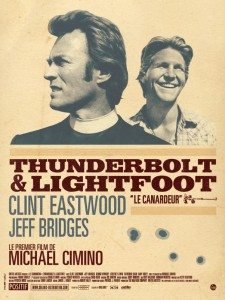 See how good Clint is? I haven’t even started and I’m already sneaking in an extra film.
See how good Clint is? I haven’t even started and I’m already sneaking in an extra film.
Thunderbolt and Lightfoot isn’t close to Clint’s best, but it’s still pretty fascinating. This, you see, is the first film directed by one Michael Cimino. Cimino’s second film, The Deer Hunter, pretty much devoured the Academy Awards in 1978 and remains a favorite of critics throughout the universe. On the other hand, Cimino’s third film, Heaven’s Gate, pretty much devoured the gritty, director-centric, 70’s cinema paradigm by spiraling insanely over budget, not being good at all, and thereby asphyxiating the producing studio, United Artists.
Since then, Cimino’s been wandering around like a guy who can’t find his other shoe. Poor fella. Won’t you rent Year of the Dragon to help a brother out?
But Thunderbolt and Lightfoot; that’s when Cimino first got behind the camera. And how, you inquire, did that happen? Clint Eastwood gave him the reins, that’s how.
Clint had developed T&L as a project for himself to direct but he was impressed by Cimino—who wrote the script on spec—and gave him his big break. If it weren’t for Clint and T&L, there would be no The Deer Hunter (or, for that matter, Heaven’s Gate…). Put that bullet in your revolver and smoke it.
Thunderbolt is an odd movie. It’s a caper film and a buddy picture and a goofy sort of action comedy. The script pairs up an experienced criminal—the Thunderbolt character played by Eastwood—with a young, naive Lightfoot—played by Jeff Bridges as if he was workshopping his “The Dude” character a few decades early. They gang up to commit robberies in widescreen Idaho.
To be honest, Bridges’ Lightfoot bugs the hell out of me in this film, but he’s sorta supposed to. He bugs the hell out of George Kennedy’s character, too, and those scenes are some of the movie’s best bits. Lightfoot’s hippie-dippy mannerisms overshadow Eastwood’s more measured portrayal of Thunderbolt in a way that’s not altogether proper, though—so he bugged Eastwood as well. Especially when Bridges got nominated for an Academy Award and Clint didn’t.
There are some beautiful shots in this picture and occasional flashes of style, so it’s worth watching to see Cimino develop his chops. Or his chop, I guess.
The film also features the unfairly forgotten George Lewis, a young Gary Busey, and Catherine Bach before she was Daisy Duke.
10. Kelly’s Heroes (1970)
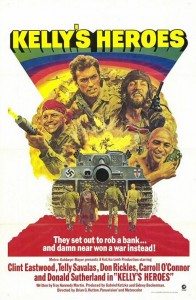 Some people will try to tell you that Clint Eastwood’s comedy films are Any Which Way You Can and its sequel, Every Which Way But Loose. They are wrong because those films are A) not funny and B) terrible. Kelly’s Heroes on the other hand, is actually funny in that Dirty Dozen sort of rag-tag bunch of unhinged soldiers way.
Some people will try to tell you that Clint Eastwood’s comedy films are Any Which Way You Can and its sequel, Every Which Way But Loose. They are wrong because those films are A) not funny and B) terrible. Kelly’s Heroes on the other hand, is actually funny in that Dirty Dozen sort of rag-tag bunch of unhinged soldiers way.
Everyone loves a good comedy about Nazis. Of which this is one.
Kelly’s Heroes isn’t all fun and games however. It’s also an authentic war caper. Eastwood plays the eponymous Kelly, an ex-officer who finds out about $16 million dollars worth of Nazi gold stuck in a bank behind enemy lines. He pulls together a gang of happy opportunists willing to risk their lives to steal it. Chief among them are Telly Savalas as Big Joe, Don Rickles as Crapgame, and Donald Sutherland as the proto-Beatnik tank commander Oddball. (Also keep an eye out for a young Harry Dean Stanton and the Love Boat’s own Gavin McLeod sending out “negative waves.”)
Visually, Kelly’s Heroes isn’t overflowing with panache. It makes up for that in terms of character however, serving up a cheerleader pyramid of ensemble acting, and liberally peppering the whole thing with engaging and inventive action sequences. Think Ocean’s Eleven meets M*A*S*H.
What puts Kelly’s Heroes on the list? It’s a big, bold, epic assault that sticks its thumb in the eye of Vietnam hawks. While ostensibly the film is set in WWII France, see if you can suss how a gang of loot-hungry grunts diving headfirst into enemy territory without justification relates (particularly once Carroll O’Connor’s major-general gets involved). And then note exactly who gets shown celebrating when the heist comes off. Some of them, hint hint, ain’t all American.
Also, as good as Eastwood is as plan mastermind, Sutherland’s Oddball is too much of a nut not to love. Check out the hat tip to Clint’s roots in the final showdown scene, complete with Morricone-esque score and dig that crazy tank assault on the train yard, too. Woof! Woof! Woof!
9. In the Line of Fire (1993)
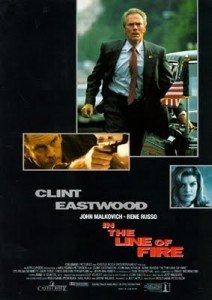 In the immortal words of Roger Murtaugh, “I’m too old for this shit.”
In the immortal words of Roger Murtaugh, “I’m too old for this shit.”
That’s basically the set up for Clint’s 1993 thriller, In the Line of Fire. He plays secret service agent Frank Horrigan against John Malkovich’s presidential-assassin-to-be Mitch Leary. Horrigan was on duty when Kennedy was shot, see, and Leary wants to make him the first agent to lose two presidents. Awwww! Isn’t that sweet?
Horrigan gets himself back on the presidential protection detail and Leary opens the cages on some cat and mouse stuff. It’s mano a mano plus Russo—that’s Rene Russo as the clearly too young love interest for arthritic old Clint.
Detractors might say that In the Line of Fire is familiar ground, and they wouldn’t be wrong. It’s basically a remake of The Day of the Jackal (either version) except it doesn’t suck badger gall bladders. Eastwood sets the standard for the “old but still in the game” action hero that’s all the rage these days. He actually looks and behaves over the hill in his wonderfully irascible way. And Malkovich does creepy and untethered better than anyone (except perhaps Vincent D’Onofrio). And behind the camera? Wolfgang Peterson who, yes, made quite a bit of crap but who also gave us Das Boot for which we will always love him.
This older, gruffer version of Clint Eastwood offers up a rare glimpse of his more vulnerable side. Horrigan is truly challenged in In the Line of Fire: out-matched, disliked, beyond his comfort zone, and short of breath. While you won’t be surprised to find out that he eventually saves the day, you may be appreciative of how Eastwood lays Horrigan’s tough facade over serious questions of self-worth.
8. Escape from Alcatraz (1979)
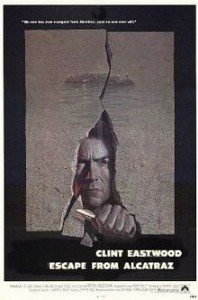 Here’s a quiz for you: Where can you see Clint Eastwood’s ass and watch him play the accordion (not at the same time, fortunately)? If you answered in Escape from Alcatraz, congratulations, you’ve got a base-level intelligence!
Here’s a quiz for you: Where can you see Clint Eastwood’s ass and watch him play the accordion (not at the same time, fortunately)? If you answered in Escape from Alcatraz, congratulations, you’ve got a base-level intelligence!
Yes. This “based on a true story” picture has Clint portraying real-life convict Frank Morris, who may or may not be today living under an assumed name in Uruguay with Catherine Bach and the corpse of Chuck Norris. This is also the first of Clinty Top 10 to be directed by Don Siegel—together they made five films and I’m including three of them. If you’re good at math and trivia, I’ll spoil the surprise by revealing I’m leaving out Two Mules for Sister Sara (1970) and Coogan’s Bluff (1968).
But back to Alcatraz. The rock. The unescapable prison from which (maybe) a few guys escaped. This is their story and it’s a stony one.
Escape from Alcatraz does what any good prison break film must; it starts by making you hate the bulls, the metal bars, and the black pit of solitary confinement. We follow Morris as he makes a few friends and learns the ropes of the Rock. When Fred Ward and Jack Thibeau show up as brothers Morris knows from elsewhere, that’s when the plot turns. Together with Larry Hankin as Charley Butts, the quartet plans and stages their audacious escape. Patrick McGoohan—better known as the star of TV’s The Prisoner—also takes a strong turn as the acidic warden.
What do I love about Escape from Alcatraz outside of the joy of Clint’s accordion stylings? There’s nothing too surprising in the story, beyond the fact that it’s more or less true. That leaves us with two things, the looming, grim countenance of Clint Eastwood and the skills of Don Siegel.
As far as Clint goes, he’s not playing a man unjustly convicted here, or one who needs freedom to tend to his ailing mother or something else lame. He’s a bad man who’s done bad things. One of those bad things will be escaping from an unescapable place. This is the sort of part Eastwood was born to play, full of snarls and narrowed eyes and clenched fists. People say that he’s an actor lacking in emotion, but that’s not true. He’s an actor who conveys much with little and he proves that in Alcatraz.
Don Siegel’s direction—the other highlight of the film—makes Alcatraz itself a lead player in the drama. For this production they had to run electricity out to the island from San Francisco and refurbish much of the then-decaying prison. If you go on a tour of the Rock today, some of what you’ll see is thanks to this film.
Unfortunately, Siegel and Eastwood had a falling out over which of their companies would produce Escape from Alcatraz. Siegel won, but this was the last film they made together as a result. It’s a damn shame.
7. Paint Your Wagon
7. High Plains Drifter (1973)
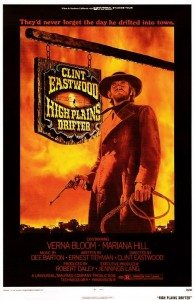 Everyone’s got their favorite Clint Eastwood line. President Reagan liked “Go ahead, make my day.” High Plains Drifter stays in the running with this gem:
Everyone’s got their favorite Clint Eastwood line. President Reagan liked “Go ahead, make my day.” High Plains Drifter stays in the running with this gem:
You’re going to look pretty silly with that knife sticking out of your ass.
That’s what you’re in for with this self-directed, sadistic, semi-supernatural Western. It’s not a pretty ride.
High Plains Drifter is the story of a town that betrayed its honest sheriff to vicious gunslingers and then made the mistake of double-crossing them, too. With the killers about to be released from prison, the town of Lago needs protection. Enter Clint Eastwood.
So far, the film sounds like fairly standard genre fare. It is, however, much rougher and uglier than a brief description reveals. Eastwood’s unnamed cowboy is a malevolent force that does and takes what he wants. Property, people, and prosperity get trampled under his heels. When the town of Lago offers him “anything he wants” to defend them, he takes their proposition literally.
Reviewers snark that High Plains Drifter feels derivative of both Sergio Leone and Don Siegel’s styles. Don’t let that bother you. There’s something here that’s unique, albeit uniquely unpleasant. It is a film about getting what’s coming to you. In this case, what’s coming is a demonic Clint Eastwood who’d be more than happy to enlarge your rectum for you with an evil-looking blade.
I kind of love it. It’s like watching the Weather Channel in Florida.
6. The Beguiled (1971)
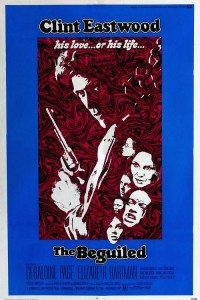 Of the Don Siegel / Clint Eastwood collaborations, The Beguiled isn’t the best, but it may be the most fascinating. It is one of those films that you really need to see as descriptions of it invariably fall short. (This was actually a problem when it came to marketing the picture, and you’ll see what I mean when I try to lay out the story for you.)
Of the Don Siegel / Clint Eastwood collaborations, The Beguiled isn’t the best, but it may be the most fascinating. It is one of those films that you really need to see as descriptions of it invariably fall short. (This was actually a problem when it came to marketing the picture, and you’ll see what I mean when I try to lay out the story for you.)
Clint plays John McBurney, a wounded Union soldier who is saved by a 12-year old out from an all-girls boarding school in Louisiana. The matron there, and the other girls of various ages, aren’t sure what to do with him. As they debate whether to turn him over to Confederate troops or not, they heal his wounds and, in their own ways, become beguiled by him.
And ‘beguiled’ is the right word, since McB is a manipulative, lying scoundrel. Then again, these women and girls aren’t sugar and spice and everything nice either. They are, if anything, even worse than he is. They are beauty in all its claws-out ugliness. That makes for ghastly good fun but it doesn’t make for an easy sell.
Particularly since the film starts with the delirious McB kissing the 12-year old.
Where The Beguiled really shines, however, is in its characterizations. Of all the roles Clint Eastwood has ever played, this may be his most challenging, complex, and convincing performance. He becomes the most likeable unlikeable character you’re ever likely to see. He doesn’t fight duels with banditos or blow up banks with artillery or even make it out of the house much. All he does play a game of chess in which he’s the king faced off with nine queens.
The poor bastard never stands a chance.
And, for those of you keeping score at home, The Beguiled is indeed a Civil War-era Western that deals with slavery. Mae Mercer plays the house slave Hallie and her portrayal of that life is a lot more nuanced than anything in more recent films. You could argue that this is not a traditional Western, but I would counter with “shut up.”
5. A Fistful of Dollars (1964)
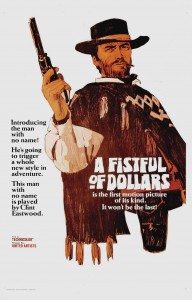 There is really only one reason that A Fistful of Dollars isn’t higher up on this list. That is because it’s a remake and above all else we value originality.
There is really only one reason that A Fistful of Dollars isn’t higher up on this list. That is because it’s a remake and above all else we value originality.
Here’s what happened. Clint had been working for years on a television show called Rawhide. While his co-starring role as Rowdy Yates was a big break for him, it wasn’t exactly the most rewarding acting gig. Rowdy, you see, was kind of an oaf. Then in 1963 his Rawhide co-star Eric Fleming turned down a role in some weird film directed by this unknown Italian director named Sergio Leone. Leone wanted to shoot a Western in Spain that would be an “unofficial remake” (read = rip off) of Akira Kurasawa’s 1961 samurai film, Yojimbo.
Yojimbo, if you haven’t seen it, is better than Fistful despite its lack of Clint Eastwood. It instead stars the magnificent Toshiro Mifune but that is a subject for another day.
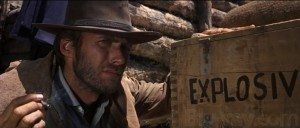
Actually, Clint doesn’t smoke. Leone insisted he use the cigarillos to help create a mask for the character.
With Fleming uninterested, Clint stepped in and starred in what would be his first significant film role. The film was a major hit in Italy, but Eastwood actually returned to Europe to film the sequel, For a Few Dollars More, and a third film in what is called a trilogy, The Good, the Bad and the Ugly, before Fistful was even released in the States.
That’s a lot of history. I apologize. Here is what you need to know:
There is a town. The town is caught between two controlling families. These two families hate each other and are constantly trying to wipe each other out. Into this hornet’s nest rides a stranger. He doesn’t take kindly to people making fun of his mule so he kills everyone. The end.
Actually, I may have skipped over some stuff. Most of that stuff is incredibly good and was, for the time, pretty durn surprising. No more gee-pardner, white hat, hop-a-long heroes here. Clint comes dropping in like a ton of anti-hero bricks, smearing a sticky streak of blood across the landscape of traditional Western mythology.
Sergio Leone also comes through hard in terms of style. A Fistful of Dollars looks a little rough with its Italian actors overdubbed in English (or vice versa in Italy), but don’t undervalue the insane violence, the intense build developed in drawn out scenes (such as duels), and how well Leone used the absolutely brilliant music of Ennio Morricone. If these things seem commonplace today this film is why.
If you keep reading this post, you will note that For a Few Dollars More (1965) is not on the list. Like most sequels, it’s not as engaging. While the story is original, it’s much muddier and missing the empathetic characters of the first film. Also, it’s less of Clint’s show as he’s nearly upstaged by Lee Van Cleef. When you do watch it—and you should—please enjoy the wonderfully insane Klaus Kinski as the Hunchback.
4. Unforgiven (1992)
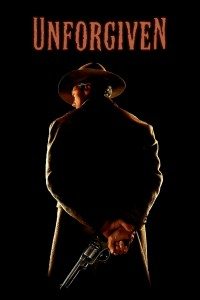 And… now’s when most of you are going to start saying, “What?! Your #2 should be #4 and I can’t believe you didn’t include The Eiger Sanction!” Let’s just nip all that in the bud, shall we? I am correct and you are incorrect. See? Wasn’t that easy? Don’t you feel better? No? Well who cares.
And… now’s when most of you are going to start saying, “What?! Your #2 should be #4 and I can’t believe you didn’t include The Eiger Sanction!” Let’s just nip all that in the bud, shall we? I am correct and you are incorrect. See? Wasn’t that easy? Don’t you feel better? No? Well who cares.
When Unforgiven first got released, I was in university taking a class on the American Western Film. Seriously. I got college credit for that. This is relevant because people went justifiably ga-ga for Unforgiven, calling it a new kind of revisionist Western and getting Clint Eastwood tattoos across their ample bosoms.
Which pissed me off because a) I had just watched a number of revisionist Westerns and had all sorts of high-falutin’ intellectual terms handy to describe them and b) I was in college. Therefore, I more or less dismissed Unforgiven for many years, feeling like it was over-rated.
I was wrong. It happens.
While Unforgiven isn’t the first or even one of the first few revisionist Westerns, it is in every sense a real goddamned film. It is the story of an ex-gunfighter who reluctantly answers the plea of women abused. Where that synopsis fails utterly is in how it does not in any way address the pure brutality that imbues every act of violence in the film. Clint Eastwood’s William Munny is rightly ashamed of his past as a murdering drunk. The cowboys who cut up the prostitute, the sadistic sheriff (Gene Hackman, kicking ass), the boastful but green wanna-be gunfighter kid—more than anything else they’re all real people. And that means when they hurt, or kill, or are killed, you feel it in a way that rarely comes across in motion pictures.
If A Fistful of Dollars took the shine off the Western hero, and The Wild Bunch hammered the finality of death into you with a thousand rounds, then Unforgiven cuts you open and lets you watch your own beating heart being used as an ashtray.
Clint Eastwood—director and star—saved this David Webb Peoples’ script for about fifteen years until he was old enough to nail the part of Munny. That means this is a ’70s script, not some crappy ’80s thing that values explosions over introspection. That also means this sucker isn’t going to end with a sunset and a chuck on the chin.
It’s going to end with your blood staining your nice Sunday clothes.
If The Beguiled’s McB is Eastwood’s most challenging role, then William Munny is perhaps the one he spent his whole life preparing for. In this part he deconstructs his entire oeuvre, takes everything he’s done since he was plodding through Rawhide and splatters its guts across the barroom floor.
Despite how that sounds, Unforgiven is not a gory feast the way you expect. Each instance of violence is made horribly tangible—and that being the case—there is no glorification. Less than none.
If you appreciate just how wrenching the violence in this film is, I’m going to give you a pointer. Check out McCabe and Mrs. Miller.
3. The Outlaw Josey Wales (1976)
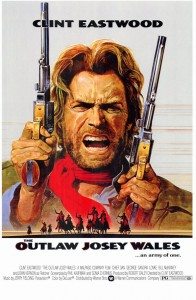 Were we just talking about revisionist Westerns? Hm. Have you seen The Outlaw Josey Wales?
Were we just talking about revisionist Westerns? Hm. Have you seen The Outlaw Josey Wales?
That’s right. Eastwood scooped himself with this film in which a Missouri farmer joins up with the Confederates after his family is massacred by pro-Union irregulars. In the way of wars since the very first war (War of the Worlds), things then get out of hand. Killing begets killing and where does it all end? If you answered “with Sondra Locke and a tobacco stained dog and Dean Wormer,” then I reckon you’re right.
While I can’t in good conscience say this is the best Clint Eastwood film, I will mumble it under my breath. Because it’s a film that speaks to me with its unconventional cadence and its complexly imperfect characters. Chief Dan George as Lone Watie, John Vernon as Fletcher, Sondra Locke in her only decent performance, and Clint as the eponymous Josie Wales—they all make you feel a little bit dirty in the best possible way. Well, the second best possible way, I guess.
Speaking of feeling dirty, did you know that Philip Kaufman actually started directing this movie—took it all the way through pre-production and shot for a couple of weeks—until Eastwood had him fired and took over? Yep. After this scandalous affair the DGA instituted the “Clint Eastwood rule” that says you can’t be a dickhead without paying a giant fine.
Why didn’t Clint like Kaufman? Kaufman was meticulous whereas Clint hates doing more than a couple of takes of anything. Also, both gentlemen had a fancy for Sondra Locke and her giant eyeballs. Go figure. In any case, Eastwood had the chops and made what’s not only one of his best films, but one of the best Westerns ever.
Josey has so much anger buckled within him and yet he can’t help but accrue a constantly growing crew of sad sack companions. They’re his shadow family. Watching Clint burn through his hatred and come out the other side, that’s what makes the film most memorable. And the dialogue, too.
Dyin’ ain’t much of a living, boy.
2. The Good, the Bad and the Ugly (1966)
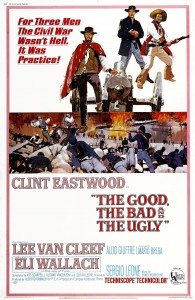 Choosing between The Good, the Bad and the Ugly and the #1 Clint Eastwood movie posed a serious dilemma for me. In the end, here’s what I decided: The GB&U is the better film, but the #1 slot goes to the film with the most Clintiness; ergo this one barely misses out on the top slot. Let’s not bicker about it.
Choosing between The Good, the Bad and the Ugly and the #1 Clint Eastwood movie posed a serious dilemma for me. In the end, here’s what I decided: The GB&U is the better film, but the #1 slot goes to the film with the most Clintiness; ergo this one barely misses out on the top slot. Let’s not bicker about it.
There really aren’t many films that make me happier than The Good, the Bad and the Ugly. This epic Spaghetti Western is theoretically the third in Sergio Leone’s “man with no name” trilogy. Really, though, the whole trilogy thing is just something people made up after the films were made. Clint Eastwood’s characters (and note the plural) dress the same and behave similarly in all three films—A Fistful of Dollars, For a Few Dollars More, and The GB&U—but there is no sequence of events, no thread of story, and all three Clint Eastwood characters in the “man with no name” trilogy have names, and they’re all different (Joe, Manco, and Blondie, respectively).
It is in The Good, the Bad and the Ugly that Leone finds the sweet spot of style and story. Taking what he learned from aping Kurasawa in his first Western and from developing his own material in the second one, here he crafts a widescreen ballet of greed, violence, and martial insanity.
The story is a complex interweaving of darting advances and setbacks. Three main characters all seek a fortune in Confederate gold. Clint Eastwood is Blondie (“the Good”), a cool, cocky bounty hunter. Lee Van Cleef is Angel Eyes (“the Bad”), a hired killer with a stony heart (quite distinct from the Colonel Mortimer character he played in For a Few Dollars More). Eli Wallach is Tuco (“the Ugly”), a bandit with few scruples but, of the three, the one with the most well-developed character. Over the course of three hours of screen time, these men switch alliances, avoid artillery, and dodge death as they try to end up rich.
As with Sergio Leone’s other Westerns, Ennio Morricone’s score elevates the epic to vertiginous heights. From the first whistling chords over the credits, you know you’re in for it. By the time the trio faces off in Sad Hill Cemetery to The Ecstasy of Gold, Tonino Delli Conni’s spinning camerawork is whipping your world into dust devils. (Recommendation: Yo Yo Ma’s album Plays Ennio Morricone is gorgeous and his Ecstasy of Gold is nothing short of transcendent.)
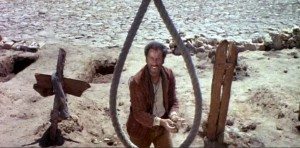
There are two kinds of men in this world; those with ropes around their necks and those who do the shooting.
The Good, the Bad and the Ugly is among my favorite films of all time. If you ever get the chance to see it projected in anamorphic 35mm spread across the screen in 2.35 : 1 aspect, do not miss it. There are a few different edits out there. My feeling is, more is better but they’re all good.
1. Dirty Harry (1971)
You’ve got to ask yourself one question: “Do I feel lucky?” Well do ya punk?
It’s a scene that is burned into our collective eye sockets. Inspector Harry Callahan staring the lawless now in the face, daring entropy to reach for its gun. Dirty Harry created the loose-cannon cop. It overturned the police procedural the way A Fistful of Dollars rewrote the Western. It is as Clint as you can get.
While I certainly hope you’ve seen Dirty Harry, if you haven’t, this film has lost none of its potency. Your tardiness will not affect your viewing experience. The film remains as visceral as the day it was shot. And, given its history, we’re lucky it was shot in the first place.
While Dirty Harry and Clint Eastwood are practically synonymous now, Clint was far from the first actor approached to play the part. Frank Sinatra, John Wayne, Steve McQueen, Robert Mitchum, Burt Lancaster, and Paul Newman all turned down the role for various reasons.
Just, for a moment, imagine John Wayne snarling his way through the role. Nuts, right pardner?
The script, too, had its meandering path. The original, written by Harry Julian and Rita M. Fink, took place in New York, was written for Wayne, and first offered to Sinatra. As players came and mostly went, writer John Milius took a pass at the script, then Terrence Malick. (Much of what Malick wrote became Magnum Force). As the project languished, it almost got fobbed off as an ABC television movie. Then Eastwood accepted the part, insisted they return to the basics of Milius’ draft, and demanded Don Siegel as a director.
In the story, San Francisco Police Inspector Harry Callahan works to stop a crazed serial killer (the excellently creepy Andy Robinson). But it’s not what he does, so much as how he does it. Frustrated by the Police Department’s restrictive rules, Callahan enforces his own stripped down version of justice.
This is far and away the best film Siegel and Eastwood made together. It has been credited with spawning the entire genre of Action films, although I think that may be stretching it a bit.
Dirty Harry makes the top of the list because beyond being an incredibly powerful film with an iconic central role, it involves you in a way that few movies of this ilk can. While it infuriated many when it was released for its rampant lack of political correctness, that’s exactly as it should be. The concepts that this film calls into question haven’t left the national conversation even forty years later. What does one do with a psychopath? How can society survive in the face of growing lawless threat?
We’ve tried many things. Electing psychopaths to public office didn’t work, so I guess we’ll just have to keep thinking about it—and re-watching Dirty Harry. (But not the sequels, which all pretty much suck. Same character, no gravitas.)
And there you have it, kids. Ten must-watch Eastwood masterpieces to keep you occupied and make you forget that ghastly empty chair business. If you need more, there’s plenty out there and some of it is even damned good. Like For a Few Dollars More. How could I leave that off the list? I must be some kind of asshole or something.

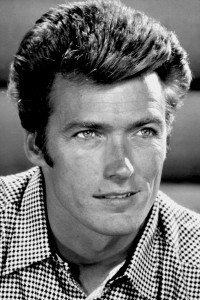
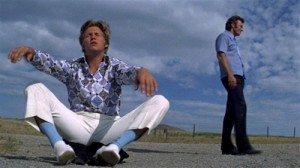
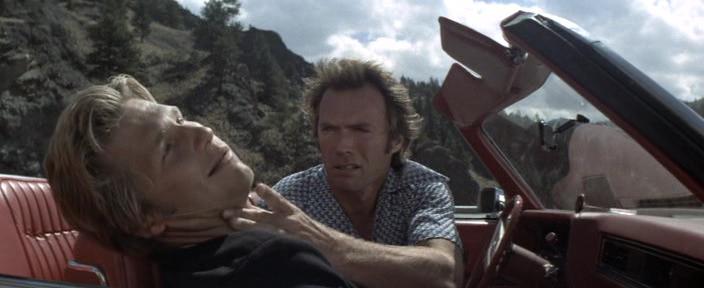
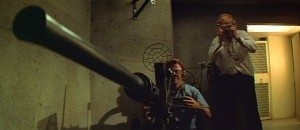
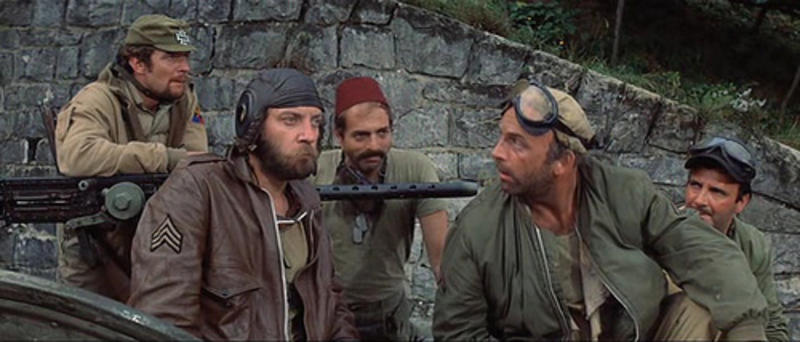
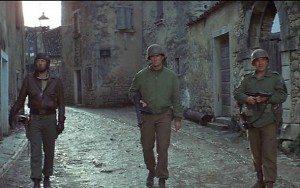
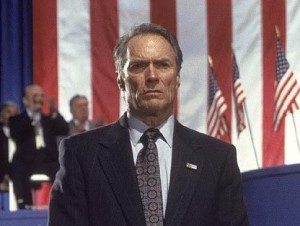
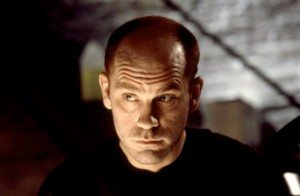
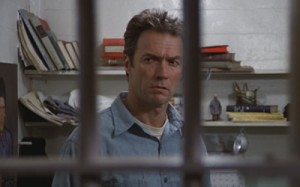
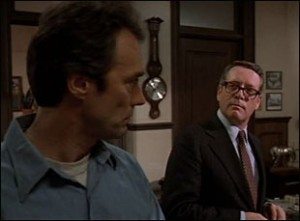
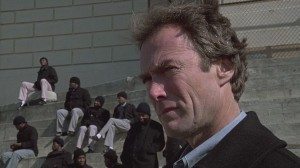
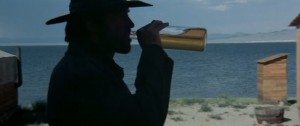
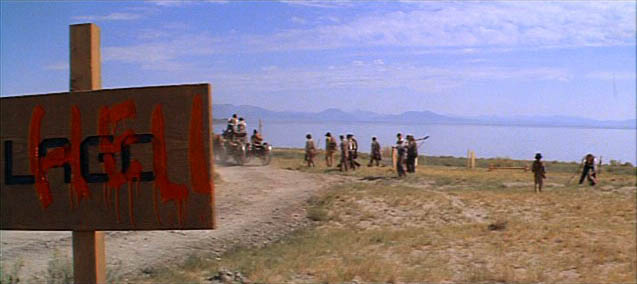
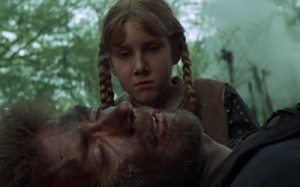
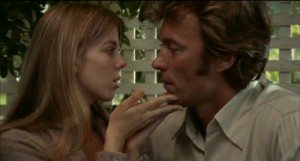
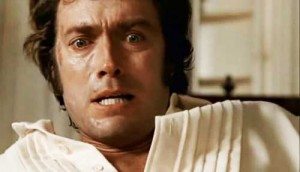
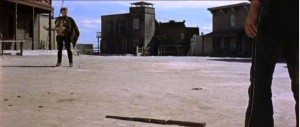
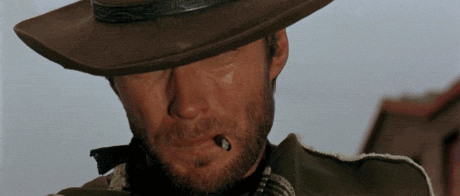
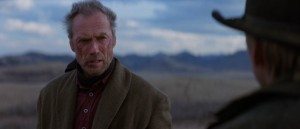
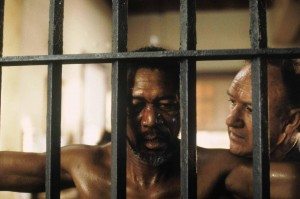
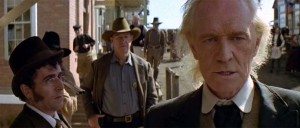
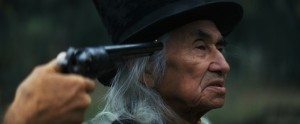
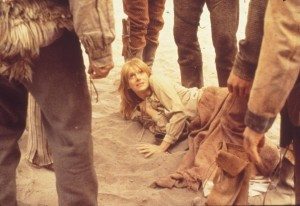
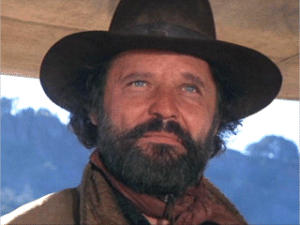
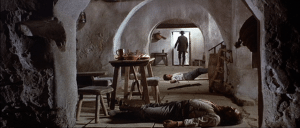
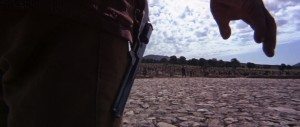
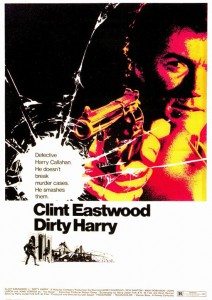
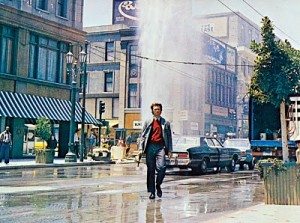
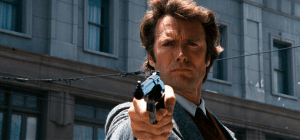
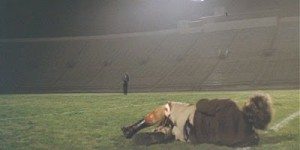
‘Unforgiven’ is one of my faves!
You’ve got good taste, Dan.
The top four are so difficult to arrange for me. There is definitely something zeitgeisty about Dirty Harry, and it’s exactly how I imagine life was for folks who experienced the 70s. And as much as I love Dirty Harry, I’ve gone back to Unforgiven and Good, Bad and Ugly way more often. There are so many amazing lines of dialogue and beautiful shots in Unforgiven. I still have trouble reconciling that Eastwood directed Unforgiven as well as that stupid empty chair bit last year (I note the chair gag didn’t make your list). Oh well, great list.
Yeah. Good Bad and Ugly is my favorite, but only like 20% because of Clint. I’ve got to give equal weight to Eli Wallach, Leone, Morricone, and slightly less to Lee Van Cleef. The other 10% goes to charity.
Dirty Harry isn’t the kind of film I like to watch frequently, but that’s because it’s so stark and hard; honest in an unpleasant way.
Unforgiven is pretty excellent and yet I never forget that I’m watching a movie when it’s on. That’s sort of odd and I just realized it now, but as real as the violence is, I don’t feel like I’m involved with real life. I can get sucked into Dirty Harry.
Outlaw Josey Wales just speaks to me. I adore all the scenes with Chief Dan George and granny and the personal nature of all the strain in the film—how much work it is to just keep moving, to stay cold to the world.
That chair thing was horrible. What a sad way for him to be remembered. Whomever let him take the stage that way should be tarred and feathered.
Outlaw Josey(or is that Jokey) Wales isn’t even a real western. It’s just some homage to the Confederacy with Eastwood playing some brain-dead backwoods hick. Dances with Wolves was better, even though it wasn’t a real western either.
Thanks Chris. I needed a good laugh.
Although I accept your Clintiness argument, for me I’d still go with Good, Bad, Ugly at number one. And while I’m glad you’ve come around some on Unforgiven, for me that’s an easy second place. Everything came together for that one. Every other line is beautifully quotable.
It’s been ages since I saw The Beguiled. I should check it out again one day soon.
Finally I’d like to give a shout-out to Tarantula from ’55, in which an uncredited Eastwood flies the jet that bombs the giant spider.
You’re right. Tarantula is much better than Million Dollar Baby.
High Plains Drifter is the one where they burn the town down at the end right? I really liked that.
Yup. First they paint it red and set out a big welcome picnic. It’s a dark film but I think it works.
Saw The Good, The bad and the Ugly in a Military Theater in Graves Concern Aschaffenburg, Germany
also guarded the theater and motor pool. Was stationed there from 1967-1969. Russians invaded Czechoslovakia in the winter of 1968 with 3.5 million men in Tanks. Jimmy Mahuron Salem, Indiana
Thanks for sharing, Jimmy. And for your service.
Yojimbo was a samurai version of the Dashiel Hammet story Red Harvest*, which was set during prohibition. It’s an excellent story, and Yojimbo and Fistful are both excellent films.
Walter Hill directed Bruce WIllis in Last Man Standing, a prohibition-era remake of Yojimbo, bringing the story full circle. It is not an excellent film.
(*Kurosawa is on record as saying it was based on ‘the Glass Key’ but that makes no sense since the plot of Yojimbo is “Red Harvest but with a ronin in it”)
Indeed. I’ve read Red Harvest many times. Excellent book!
And if you want a film version of the Glass Key, Alan Ladd starred in a good one and Miller’s Crossing is said to be based on the novel.
Play Misty for Me!? No?
I’m going with ‘no’ Bonnie. I like it (and like it more now that Jessica Walter is seeing a big comeback with Arrested Development and Archer), but it’s just sort of sludgy as a film and hard to adore. I haven’t seen it too recently (or watched it through more than once), but I don’t think it belongs on a 10 best list. I’d put For a Few Dollars More on here way before Play Misty for Me.
Which actually brings up something I’ve been nebulously thinking on of late, that, perhaps, the best movie of the man with no name trilogy is in fact For A Few Dollars More. It is without question, I now believe, a better movie than A Fistful of Dollars, which great as it is, is still a shot-for-shot theft of Yojimbo, and really not at all as good (although, yeah, the Morricone soundtrack is possibly the greatest soundtrack of all time).
Is it better than Good/Bad/Ugly? Okay, maybe not. But then again, there’s something very pure and simple and powerful about For A Few. Leone learned how to make the westerns he needed to make by ripping of Kurosawa, and then brought it all to life in his own way with For A Few. With Good/Bad, he went epic in the way he’d try to go with pretty much everything else he ever made. None of which are quite as good as Good/Bad. So okay, maybe it is the best. I just think everyone needs to go watch For A Few again and give it another shot.
Harrumph. Well. I see what you’re saying. But I stick with my read is that Fistful is a rip-off, but an excellent one and Few More is a daring, but not truly successful attempt at originality, followed by GBU, which is one of the best films ever made.
But yeah. People should watch Few More again. Me included.
Rereading this now, nearly a decade later, I am stunned I put Outlaw Josey Wales so high up in the ranking. I still like it’s characters (and the book it’s based on, despite it’s distasteful backstory) but re-watching it not so long ago, I was… not happy. It’s kind of a mess?
I’m not going to rejigger this list to suit my new opinions but yeah. Maybe it’s #10 for me now? Maybe?
Funny, I just watched this recently too, and didn’t much care for it. I’d forgotten how in one’s face his being wronged by those damn Union soliders is. And yeah, I don’t think I’d known before that the book was written under a pseodonym by some KKK wizard or whatever, who wanted to glorify the noble southern man.